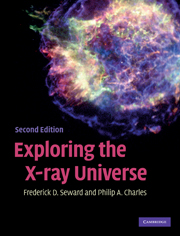Book contents
- Frontmatter
- Contents
- List of acronyms
- Foreword
- Chapter 1 Birth and childhood of X-ray astronomy
- Chapter 2 X-ray emission and interaction with matter
- Chapter 3 Tools and techniques
- Chapter 4 Solar system X-rays
- Chapter 5 X-ray absorption and scattering in the Interstellar Medium
- Chapter 6 Active stellar coronae
- Chapter 7 Early-type stars
- Chapter 8 Supernova explosions and their remnants
- Chapter 9 Neutron stars, pulsars, pulsar wind nebulae, and more supernova remnants
- Chapter 10 Cataclysmic variable stars
- Chapter 11 X-ray binaries
- Chapter 12 Black-hole X-ray binaries
- Chapter 13 Normal and starburst galaxies
- Chapter 14 Active galactic nuclei
- Chapter 15 Clusters of galaxies
- Chapter 16 The diffuse X-ray background
- Chapter 17 Gamma-ray bursts
- Index
- Plate section
Chapter 6 - Active stellar coronae
Published online by Cambridge University Press: 05 June 2012
- Frontmatter
- Contents
- List of acronyms
- Foreword
- Chapter 1 Birth and childhood of X-ray astronomy
- Chapter 2 X-ray emission and interaction with matter
- Chapter 3 Tools and techniques
- Chapter 4 Solar system X-rays
- Chapter 5 X-ray absorption and scattering in the Interstellar Medium
- Chapter 6 Active stellar coronae
- Chapter 7 Early-type stars
- Chapter 8 Supernova explosions and their remnants
- Chapter 9 Neutron stars, pulsars, pulsar wind nebulae, and more supernova remnants
- Chapter 10 Cataclysmic variable stars
- Chapter 11 X-ray binaries
- Chapter 12 Black-hole X-ray binaries
- Chapter 13 Normal and starburst galaxies
- Chapter 14 Active galactic nuclei
- Chapter 15 Clusters of galaxies
- Chapter 16 The diffuse X-ray background
- Chapter 17 Gamma-ray bursts
- Index
- Plate section
Summary
The Sun
The Sun is close and has been studied intensively. It radiates strongly from radio- to X-ray frequencies and, because of solar-terrestrial effects, has been monitored by an armada of spacecraft for 50 years. There were the OSO spacecraft (which also observed other cosmic sources) (1962–1978), Skylab (1973), Solar Max (1980–1989), Yohkoh (1991–2001), SOHO (1995–), TRACE (1998), and Hinode (2006). Solar X-ray emission is now continuously measured by a series of GOES spacecraft, and current data are available online almost instantaneously (NOAA/SWPC, 2009a). In this section we show only a few observations which illustrate things to keep in mind when considering the emission of other stars. The data are spectacular, and we regret not having room to include more. For a more thorough overview of solar observations and theory, there is an excellent book by Golub and Pasachoff (1997). Movies of EUV and X-ray images of the Sun can be viewed on several websites (e.g. TRACE, 2009; XRT, 2009).
An historical puzzle
Why should there be detectable X-rays from the Sun at all? Certainly not on the basis of its everyday visible appearance. The optical spectrum of the Sun can be represented quite well by a simple blackbody at a temperature of about 6000 K. Such an object should produce no detectable X-ray flux, whereas the amount actually seen implies the presence of material at a temperature of at least 1 million degrees!
- Type
- Chapter
- Information
- Exploring the X-ray Universe , pp. 60 - 83Publisher: Cambridge University PressPrint publication year: 2010



